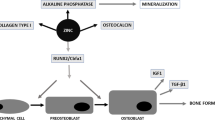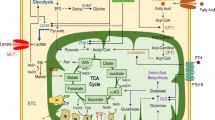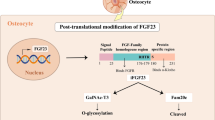Abstract
Disturbed zinc (Zn) homeostasis in mammals is mainly characterized by impaired bone generation accompanied with growth retardation. However, the underlying mechanisms that determine how Zn controls bone homeostasis remain to be defined. Zn homeostasis is tightly controlled by Zn transporter families. Recent studies have shown that Zn transporter-mediated Zn ion (Zn2+) behaves as a signaling factor, called Zn signal, that exerts a multiple function in cellular events, showing why Zn has a vital effect on mammalian bone growth and regeneration. This perspective put importance on the principal mechanisms of Zn participation in mammalian bone homeostasis, shifting our focus on the role of Zn from simply a nutrient to a signaling molecule that fine-tunes intracellular signaling events.



Similar content being viewed by others
Abbreviations
- ZIP:
-
Zrt/Irt-like protein
- ZnT:
-
Zn transporter
- Zn2+ :
-
Zn ion
- GPCR:
-
G protein-coupled receptor
- BMP:
-
Bone morphogenetic protein
- TGF-β:
-
Transforming growth factor-beta
- KO:
-
Knockout
- STAT:
-
Signal transducer and activator for transcription
- JAK:
-
Janus kinase
- AE:
-
Acrodermatitis enteropathica
- EDS:
-
Ehlers–Danlos syndrome
- SD-EDS:
-
Spondylodysplastic EDS
- cAMP:
-
Cyclic adenosine monophosphate
- PDE:
-
Phosphodiesterase
- GH:
-
Growth hormone
- IGF-I:
-
Insulin-like growth factor
- GHRH:
-
Growth hormone-releasing hormone
- GHRHR:
-
Growth hormone-releasing hormone receptor
- PTHrP:
-
Parathyroid hormone-related peptide
- PTH1R:
-
Parathyroid hormone 1 receptor
- SMAD:
-
Contraction of Sma and Mad (mothers against decapentaplegic)
References
Prasad AS (1995) Zinc: an overview. Nutrition 11:93–99
Prasad AS, Halsted JA, Nadimi M (1961) Syndrome of iron deficiency anemia, hepatosplenomegaly, hypogonadism, dwarfism and geophagia. Am J Med 31:532–546
Bergman B, Soremark R (1968) Autoradiographic studies on the distribution of zinc-65 in mice. J Nutr 94:6–12
Yamaguchi M, Gao YH (1998) Potent effect of zinc acexamate on bone components in the femoral-metaphyseal tissues of elderly female rats. Gen Pharmacol 30:423–427
Hirano T, Murakami M, Fukada T, Nishida K, Yamasaki S et al (2008) Roles of zinc and zinc signaling in immunity: zinc as an intracellular signaling molecule. Adv Immunol 97:149–176
Maret W (2011) Metals on the move: zinc ions in cellular regulation and in the coordination dynamics of zinc proteins. Biometals 24:411–418
Fukada T, Yamasaki S, Nishida K, Murakami M, Hirano T (2011) Zinc homeostasis and signaling in health and diseases: zinc signaling. J Biol Inorg Chem 16:1123–1134
Haase H, Maret W (2003) Intracellular zinc fluctuations modulate protein tyrosine phosphatase activity in insulin/insulin-like growth factor-1 signaling. Exp Cell Res 291:289–298
Nishida K, Hasegawa A, Nakae S, Oboki K, Saito H et al (2009) Zinc transporter Znt5/Slc30a5 is required for the mast cell-mediated delayed-type allergic reaction but not the immediate-type reaction. J Exp Med 206:1351–1364
Yamashita S, Miyagi C, Fukada T, Kagara N, Che YS et al (2004) Zinc transporter LIVI controls epithelial-mesenchymal transition in zebrafish gastrula organizer. Nature (Lond) 429:298–302
Kitabayashi C, Fukada T, Kanamoto M, Ohashi W, Hojyo S et al (2010) Zinc suppresses Th17 development via inhibition of STAT3 activation. Int Immunol 22:375–386
Nilsson O, Marino R, De Luca F, Phillip M, Baron J (2005) Endocrine regulation of the growth plate. Horm Res 64:157–165
Procter AM, Phillips JA 3rd, Cooper DN (1998) The molecular genetics of growth hormone deficiency. Hum Genet 103:255–272
MacDonald RS (2000) The role of zinc in growth and cell proliferation. J Nutr 130:1500S–1508S
Kronenberg HM (2003) Developmental regulation of the growth plate. Nature (Lond) 423:332–336
Rossi L, Migliaccio S, Corsi A, Marzia M, Bianco P et al (2001) Reduced growth and skeletal changes in zinc-deficient growing rats are due to impaired growth plate activity and inanition. J Nutr 131:1142–1146
Michaelsson G, Ljunghall K, Danielson BG (1980) Zinc in epidermis and dermis in healthy subjects. Acta Dermato-Venereol 60:295–299
Molokhia MM, Portnoy B (1969) Neutron activation analysis of trace elements in skin. 3. Zinc in normal skin. Br J Dermatol 81:759–762
Cobourne MT, Sharpe PT (2003) Tooth and jaw: molecular mechanisms of patterning in the first branchial arch. Arch Oral Biol 48:1–14
Cao X, Chen D (2005) The BMP signaling and in vivo bone formation. Gene (Amst) 357:1–8
Akhurst RJ (2004) TGF beta signaling in health and disease. Nat Genet 36:790–792
Mizuguchi T, Collod-Beroud G, Akiyama T, Abifadel M, Harada N et al (2004) Heterozygous TGFBR2 mutations in Marfan syndrome. Nat Genet 36:855–860
Gaither LA, Eide DJ (2001) Eukaryotic zinc transporters and their regulation. Biometals 14:251–270
Kambe T, Yamaguchi-Iwai Y, Sasaki R, Nagao M (2004) Overview of mammalian zinc transporters. Cell Mol Life Sci 61:49–68
Fukada T, Kambe T (2011) Molecular and genetic features of zinc transporters in physiology and pathogenesis. Metallomics 3:662–674
Kambe T (2011) An overview of a wide range of functions of ZnT and Zip zinc transporters in the secretory pathway. Biosci Biotechnol Biochem 75:1036–1043
Kambe T, Weaver BP, Andrews GK (2008) The genetics of essential metal homeostasis during development. Genesis 46:214–228
Huang L, Gitschier J (1997) A novel gene involved in zinc transport is deficient in the lethal milk mouse. Nat Genet 17:292–297
Chowanadisai W, Lonnerdal B, Kelleher SL (2006) Identification of a mutation in SLC30A2 (ZnT-2) in women with low milk zinc concentration that results in transient neonatal zinc deficiency. J Biol Chem 281:39699–39707
Wang X, Zhou B (2010) Dietary zinc absorption: a play of Zips and ZnTs in the gut. IUBMB Life 62:176–182
Wang K, Zhou B, Kuo YM, Zemansky J, Gitschier J (2002) A novel member of a zinc transporter family is defective in acrodermatitis enteropathica. Am J Hum Genet 71:66–73
Kury S, Dreno B, Bezieau S, Giraudet S, Kharfi M et al (2002) Identification of SLC39A4, a gene involved in acrodermatitis enteropathica. Nat Genet 31:239–240
Dufner-Beattie J, Weaver BP, Geiser J, Bilgen M, Larson M et al (2007) The mouse acrodermatitis enteropathica gene Slc39a4 (Zip4) is essential for early development and heterozygosity causes hypersensitivity to zinc deficiency. Hum Mol Genet 16:1391–1399
Wang F, Kim BE, Petris MJ, Eide DJ (2004) The mammalian Zip5 protein is a zinc transporter that localizes to the basolateral surface of polarized cells. J Biol Chem 279:51433–51441
Huang ZL, Dufner-Beattie J, Andrews GK (2006) Expression and regulation of SLC39A family zinc transporters in the developing mouse intestine. Dev Biol 295:571–579
Dufner-Beattie J, Kuo YM, Gitschier J, Andrews GK (2004) The adaptive response to dietary zinc in mice involves the differential cellular localization and zinc regulation of the zinc transporters ZIP4 and ZIP5. J Biol Chem 279:49082–49090
Wang X, Wu Y, Zhou B (2009) Dietary zinc absorption is mediated by ZnT1 in Drosophila melanogaster. FASEB J 23:2650–2661
Hojyo S, Fukada T, Shimoda S, Ohashi W, Bin BH et al (2011) The zinc transporter SLC39A14/ZIP14 controls G-protein coupled receptor-mediated signaling required for systemic growth. PLoS ONE 6:e18059
Kronenberg HM (2006) PTHrP and skeletal development. Ann N Y Acad Sci 1068:1–13
Ohlsson C, Bengtsson BA, Isaksson OG, Andreassen TT, Slootweg MC (1998) Growth hormone and bone. Endocr Rev 19:55–79
Bin BH, Fukada T, Hosaka T, Yamasaki S, Ohashi W et al (2011) Biochemical characterization of human ZIP13 protein: a homo-dimerized zinc transporter involved in the spondylocheiro dysplastic Ehlers–Danlos syndrome. J Biol Chem 286:40255–40265
Fukada T, Civic N, Furuichi T, Shimoda S, Mishima K et al (2008) The zinc transporter SLC39A13/ZIP13 is required for connective tissue development; its involvement in BMP/TGF-beta signaling pathways. PLoS One 3:e3642
Fukada T, Asada Y, Mishima K, Shimoda S, Saito I (2011) Slc39a13/Zip13: a crucial zinc transporter involved in tooth development and inherited disorders. J Oral Biosci 53:1–12
Steinmann B, Royce PM (eds) (2002) Connective tissue and its heritable disorders, 2nd edn. Wiley-Liss, New York
Steinmann B, Royce PM, Superti-Furga A (2002) The Ehlers–Danlos syndrome. In: Steinmann B, Royce PM (eds) Connective tissue and its heritable disorders, 2nd edn. Wiley-Liss, New York, pp 431–524
Rauch F, Glorieux FH (2004) Osteogenesis imperfecta. Lancet 363:1377–1385
Warman ML, Cormier-Daire V, Hall C, Krakow D, Lachman R et al (2011) Nosology and classification of genetic skeletal disorders: 2010 revision. Am J Med Genet A 155A:943–968
Giunta C, Elcioglu NH, Albrecht B, Eich G, Chambaz C et al (2008) Spondylocheiro dysplastic form of the Ehlers–Danlos syndrome–an autosomal-recessive entity caused by mutations in the zinc transporter gene SLC39A13. Am J Hum Genet 82:1290–1305
Inoue K, Matsuda K, Itoh M, Kawaguchi H, Tomoike H et al (2002) Osteopenia and male-specific sudden cardiac death in mice lacking a zinc transporter gene, Znt5. Hum Mol Genet 11:1775–1784
Hambidge KM, Krebs NF (2007) Zinc deficiency: a special challenge. J Nutr 137:1101–1105
Hambidge M (2000) Human zinc deficiency. J Nutr 130:1344S–1349S
Yamasaki S, Hasegawa A, Hojyo S, Ohashi W, Fukada T et al (2012) A novel role of the L-type calcium channel alpha1D subunit as a gatekeeper for intracellular zinc signaling: zinc wave. PLOS ONE 7:e39654
Soysa NS, Alles N (2009) NF-kappaB functions in osteoclasts. Biochem Biophys Res Commun 378:1–5
Weaver BP, Dufner-Beattie J, Kambe T, Andrews GK (2007) Novel zinc-responsive post-transcriptional mechanisms reciprocally regulate expression of the mouse Slc39a4 and Slc39a5 zinc transporters (Zip4 and Zip5). Biol Chem 388:1301–1312
Acknowledgments
We thank Dr. Toshio Hirano, Mr. Masami Kawamura, Ms. Ayumi Ito, Ms. Mayumi Hara, and Ms. Reiko Kimura for their sincere support and contributions. I also thank Dr. Andrea Superti-Furga for the use of the human case images. This work was supported by grants from the Ministry of Education, Culture, Sports, Science and Technology of Japan, The Foundation of Growth Science (Fukada), The Kanagawa Nanbyo Study Foundation (Fukada), The Naito Foundation (Fukada), and The Takeda Science Foundation (Furuichi).
Author information
Authors and Affiliations
Corresponding author
About this article
Cite this article
Fukada, T., Hojyo, S. & Furuichi, T. Zinc signal: a new player in osteobiology. J Bone Miner Metab 31, 129–135 (2013). https://doi.org/10.1007/s00774-012-0409-6
Received:
Accepted:
Published:
Issue Date:
DOI: https://doi.org/10.1007/s00774-012-0409-6




